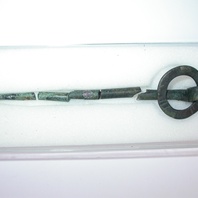
Viking Objects
Ring-headed Pin (2004-311-sf245)
This ring-headed pin was uncovered in a cremation burial which was generally unfurnished and containing little evidence. This type of pin was fairly common throughout the Viking Age and was used to hold a cloak around one’s body.
Read More
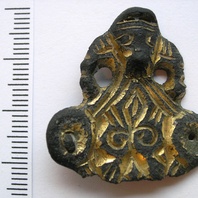
Viking Objects
Equal-Armed Brooch (SWYOR-50BAF5)
A fragment of a Viking Age equal-armed brooch found at Harworth Bircotes, Nottinghamshire. This fragment is the terminal of the brooch and resembles brooches found at Birka, Sweden. Its decoration consists of a Borre style animal with gripping arms or legs. This is one of only six Scandinavian, Viking period equal-armed brooches recorded in England. For more information on Scandinavian jewellery in England check out our blog: Brooches, Pendants and Pins: Scandinavian Dress Accessories in England.
Read More
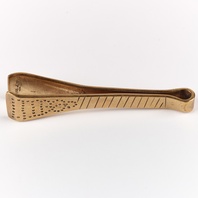
Viking Objects
Reproduction Tweezers
Tweezers were an essential toilet item for the Vikings and most people would have had their own. They could be highly decorated as were many personal possessions. They would have been carried suspended from a brooch or belt.
Read More
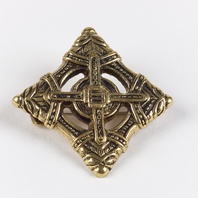
Viking Objects
Reproduction Lozenge Brooch
A copper alloy lozenge brooch in the Borre style based off a find in Lincolnshire. This type of brooch was common throughout the Danelaw in the Viking Age and was used as an accessory by women who wore Scandinavian dress. Scandinavian brooches came in a variety of sizes and shapes which included disc, trefoil, lozenge, equal-armed, and oval shapes. The different brooch types served a variety of functions in Scandinavian female dress with oval brooches typically being used as shoulder clasps for apron-type dresses and the rest being used to secure an outer garment to an inner shift. Anglo-Saxon brooches do not match this diversity of form with large disc brooches being typical of ninth century dress styles with smaller ones becoming more popular in the later ninth and tenth centuries. However, since disc brooches were used by both Anglo-Saxon and Scandinavian women they are distinguished by their morphology. Scandinavian brooches were typically domed with a hollow back while Anglo-Saxon brooches were usually flat. Moreover, Anglo-Saxon brooches were worn singly without accompanying accessories.
Read More
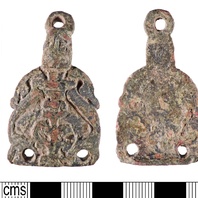
Viking Objects
Stirrup-Strap Mount (LIN-D274D5)
This Anglo-Scandinavian cast copper-alloy stirrup-strap mount is decorated with zoomorphic ornamentation. It has been classified as a William Class A Type 6 mount.
Read More
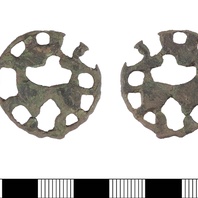
Viking Objects
Urnes-Style Mount (LIN-FA6943)
This copper-alloy mount features Urnes-style openwork decoration.
Read More
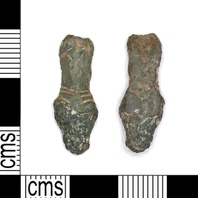
Viking Objects
Anglo-Scandinavian Strap-End (LEIC-1DD0CD)
This copper-alloy strap-end fragment is decorated in an Anglo-Scandinavian style consisting of a triangular cross-sectioned shaft which terminates in a triangular-shaped animal head. It is classed as a Thomas Class B, Type 4 strap-end which were introduced during the later eighth or early ninth century and remained popular into the eleventh century.
Read More
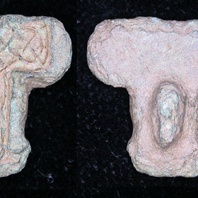
Viking Objects
Irish Gilded Mount (LEIC-09D1C8)
This fragment of a gilded copper-alloy mount is roughly T-shaped, and has a raised border around a panel of chip-carved interlace which has traces of gilding. It is possible that it made its way to England prior to Viking incursions but it is equally likely that the Vikings brought this brooch with them as plunder after raiding various areas in Ireland.
Read More
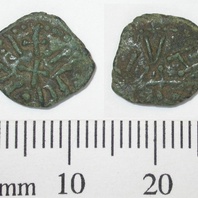
Viking Objects
Northumbrian Styca (DENO-EF4544)
The blundered legends on this example suggest it is an imitation of stycas minted for a Northumbrian ruler or the Archbishops of York. While Wessex and Mercia were using silver coinage as part of their monetary economy, Northumbria was using copper coins known as stycas, which may have contained trace amounts of silver. The concentration of these coins at sites such as Torksey and ARSNY suggests that they could have remained in circulation after the fall of Northumbria in 866 but were taken to the sites by the Vikings during their campaigning. They were not much use to the Vikings within their silver-based bullion economy but it is suggested that they were treated as raw material and were used as commodity money instead. The evidence for the production of copper-alloy strap-ends at Torksey and ARSNY supports this idea that the stycas were used for production.
Read More
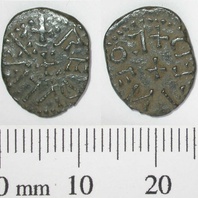
Viking Objects
Northumbrian Styca (DENO-60AFD2)
This copper-alloy styca was probably minted by the moneyer Coenred in the name of King Redwulf of Northumbria. While Wessex and Mercia were using silver coinage as part of their monetary economy, Northumbria was using copper coins known as stycas, which may have contained trace amounts of silver. The concentration of these coins at sites such as Torksey and ARSNY suggests that they could have remained in circulation after the fall of Northumbria in 866 but were taken to the sites by the Vikings during their campaigning. They were not much use to the Vikings within their silver-based bullion economy but it is suggested that they were treated as raw material and were used as commodity money instead. The evidence for the production of copper alloy strap-ends at Torksey and ARSNY supports this idea that the stycas were used for production.
Read More
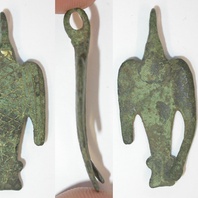
Viking Objects
Bird Pendant (DENO-55AE35)
A pendant of similar shape although with different decoration is dated to the second half of the ninth century from Yaroslavl, Russia. The bird symbol, very similar to the one depicted on this pendant, was used by the Rurik dynasty which had started the conquest of Slavic lands in the mid-ninth century and later formed the polity of Rus’. With some exceptions, pendants were generally worn by women as an accessory to Scandinavian dress.
